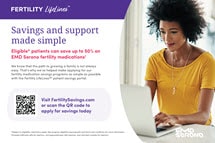*Subject to eligibility; restrictions apply. See program eligibility requirements and terms and conditions for more information.
†RFF = revised formulation female.
Patient resources for your practice
The Fertility LifeLines™ resource hub offers easy access to our downloadable injection guides and prescribing information—in multiple languages, which you can utilize as you discuss our fertility medications with your patients.




Patients can also call a live support line for insurance and savings program information and for infertility emotional support.
IMPORTANT RISK INFORMATION & INDICATIONS AND USAGE
Summary of Contraindications
Gonal-f® (follitropin alfa injection) RFF* Redi-ject® and Gonal-f® (follitropin alfa for injection) Multi-Dose are contraindicated in patients with prior hypersensitivity to r-hFSH or excipients, high levels of FSH indicating primary gonadal failure, pregnancy, uncontrolled thyroid, adrenal or pituitary disorders, sex hormone dependent tumors of the reproductive tract/accessory organs, tumors of pituitary gland or hypothalamus, abnormal uterine bleeding of undetermined origin and ovarian cyst or enlargement of undetermined origin.
Please scroll for full IMPORTANT RISK INFORMATION for Gonal-f® RFF* Redi-ject® and Gonal-f® Multi-Dose and click here for full Prescribing Information for each individual product.
RFF : revised formulation female.
Important Risk Information for Gonal-f® RFF* Redi-ject® (follitropin alfa for injection)
Contraindications:
- Prior hypersensitivity to rhFSH preparations or excipients
- high levels of FSH indicating primary gonadal failure
- pregnancy – apprise women of the potential hazard to the fetus if administered during pregnancy
- uncontrolled non-gonadal endocrinopathies (thyroid, adrenal, pituitary disorders)
- sex hormone dependent tumors of the reproductive tract and accessory organs
- tumors of pituitary gland or hypothalamus
- abnormal uterine bleeding of undetermined origin
- ovarian cyst or enlargement of undetermined origin, not due to polycystic ovary syndrome.
Warnings and Precautions:
- For use by physicians specializing in fertility treatment or reproductive health and only when appropriate monitoring facilities are available. Gonal-f® RFF Redi-ject® contains a gonadotropic substance capable of causing Ovarian Hyperstimulation Syndrome (OHSS) in women with or without pulmonary or vascular complications. Careful selection should be given to the diagnosis of infertility and the selection so candidates for therapy. The lowest effective dose should be used.
- Hypersensitivity Reactions and Anaphylaxis: Serious systemic hypersensitivity reactions, including anaphylaxis, have been reported in post-marketing experience. Symptoms have included dyspnea, facial edema, pruritis, and urticaria. If an anaphylactic or other serious allergic reaction occurs, initiate appropriate therapy including supportive measures if cardiovascular instability and/or respiratory compromise occur, and discontinue further use.
- Abnormal Ovarian Enlargement: Treatment should be individualized and the lowest effective dose should be used. Use of ultrasound monitoring of ovarian response and/or measurement of serum estradial levels is important to minimize the risk of ovarian stimulation. If the ovaries are enlarged on the last day of therapy, hCG should not be administered to reduce the risk of developing OHSS. Prohibit intercourse in women with significant ovarian enlargement.
- Ovarian Hyperstimulation Syndrome (OHSS): OHSS occurs after gonadotropin treatment discontinuation and can develop rapidly. If there is evidence that OHSS may be developing prior to hCG administration, hCG must be withheld. If serious OHSS occurs, gonadotropins, including hCG, should be stopped and consider if hospitalization is needed.
- Pulmonary and Vascular Complications: Serious pulmonary complications (e.g., atelectasis, acute respiratory distress syndrome and exacerbation of asthma) have been reported in women treated with gonadotropins. Thromboembolic events both in association with, and separate from OHSS have been reported in women treated with gonadotropins including Gonal-f® RFF*. Women with generally recognized risk factors for thrombosis, such as personal or family history, severe obesity, or thrombophilia, may have an increased risk of venous or arterial thromboembolic events, during or following treatment with gonadotropins. Sequelae of such reactions have included venous thrombophlebitis, pulmonary embolism, pulmonary infarction, cerebral vascular occlusion (stroke), and arterial occlusion resulting in loss of limb and rarely in myocardial infarctions. In rare cases, pulmonary complications and/or thromboembolic reactions have resulted in death. In women with recognized risk factors, the benefits of OI and ART need to be weighed against the risks.
- Ovarian torsion: has been reported after treatment with gonadotropins. This may be related to OHSS, pregnancy, previous abdominal surgery, past history of ovarian torsion, previous or current ovarian cyst and polycystic ovaries. Damage to the ovary due to reduced blood supply can be limited by early diagnosis and immediate detorsion.
- Multi-fetal Gestation and Birth: During clinical trials, multiple births occurred in 20% of live births in women receiving therapy for ovulation induction and 35.1% of live births in women undergoing ART. The woman and her partner should be advised of the potential risk of multi-fetal gestation and birth before beginning therapy with Gonal-f® RFF* Redi-ject®.
- Congenital Malformations: The incidence of congenital malformations after some ART [specifically in vitro fertilization (IVF) or intracytoplasmic sperm injection (ICSI)] may be slightly higher than after spontaneous conception. This slightly higher incidence is thought to be related to differences in parental characteristics (e.g., maternal age, maternal and paternal genetic background, sperm characteristics) and to the higher incidence of multi-fetal gestations after IVF or ICSI.
- Ectopic Pregnancy: Since women undergoing ART often have tubal abnormalities, the incidence of ectopic pregnancy may be increased.
- Spontaneous Abortion: The incidence of spontaneous abortion (miscarriage) may be increased. However, causality has not been established. This may be a factor of the underlying infertility.
- Ovarian Neoplasms: Both benign and malignant ovarian neoplasms have been infrequently reported in women who have had multiple drug therapy for controlled ovarian stimulation; causality has not been established.
- Laboratory Tests: Both ultrasound and serum estradiol measurement should be used to monitor follicular growth and maturation, timing of the ovulatory trigger, detecting ovarian enlargement, and minimizing the risk of the OHSS and multiple gestation.
Adverse Reactions:
The most common adverse reactions (≥5%) in OI include: headache, abdominal pain, and ovarian hyperstimulation. The most common adverse reactions (≥5%) in ART include: abdominal pain, nausea, abdominal enlargement, headache, and injection site reactions (pain, bruising).
Patient Counseling:
In addition to advising patients about the proper use of treatment, the duration and necessity of monitoring, handling of missed doses, OHSS, and multi-fetal gestation and birth, patients should be advised to review the Patient Information Leaflet which contains risk information, follow the Instructions for Use for the Gonal-f® RFF* Redi-ject®, not share the device or reuse needles, and to ask their Healthcare Provider about questions.
Indications and Usage:
- Induction of ovulation (OI) and pregnancy in oligo-anovulatory women in whom the cause of infertility is functional and not due to primary ovarian failure
- Development of multiple follicles in ovulatory women as part of an Assisted Reproductive Technology (ART) cycle.
Prior to treatment complete an evaluation of female and male partners to determine infertility diagnosis and fertility status. Primary ovarian failure and pregnancy should be excluded.
For more information, please see the full Prescribing Information and Instructions for Use for Gonal-f® RFF* Redi-ject®.
*RFF = revised formulation female.
Important Risk Information for Gonal-F® Multi-Dose (follitropin alfa for injection)
Contraindications:
Gonal-F® Multi-Dose is contraindicated in women and men who exhibit:
- Prior hypersensitivity to recombinant follicle stimulating hormone (FSH) products or one of their excipients. Reactions have included anaphylaxis.
- High levels of FSH indicating primary gonadal failure
- The presence of uncontrolled non-gonadal endocrinopathies (e.g., thyroid, adrenal, or pituitary disorders)
- Sex hormone dependent tumors of the reproductive tract and accessory organs
- Tumors of pituitary gland or hypothalamus
Gonal-F Multi-Dose is also contraindicated in women who exhibit:
- Abnormal uterine bleeding of undetermined origin
- Ovarian cyst or enlargement of undetermined origin
WARNINGS
Hypersensitivity Reactions and Anaphylaxis
In the post-marketing experience, serious systemic hypersensitivity reactions, including anaphylaxis, have been reported with use of Gonal-F Multi-Dose and Gonal-F RFF. Symptoms have included dyspnea, facial edema, pruritis, and urticaria. If an anaphylactic or other serious allergic reaction occurs, initiate appropriate therapy including supportive measures if cardiovascular instability and/or respiratory compromise occur, and discontinue further use.
Overstimulation of the Ovary During FSH Therapy
If serious ovarian hyperstimulation syndrome (OHSS) occurs, stop gonadotropins, including Gonal-F Multi-Dose and human chorionic gonadotropin (hCG), and consider whether the woman needs to be hospitalized.
OHSS increases the risk of injury to the ovary. Avoid pelvic examination or intercourse, as these may cause rupture of an ovarian cyst, which may result in hemoperitoneum.
A physician experienced in the management of this syndrome, or who is experienced in the management of fluid and electrolyte imbalances should be consulted.
Pulmonary and Vascular Complications:
Serious pulmonary conditions (for example, atelectasis, acute respiratory distress syndrome and exacerbation of asthma) have been reported in women treated with gonadotropins, including Gonal-F Multi-Dose. In addition, thromboembolic events both in association with, and separate from OHSS have been reported in women treated with gonadotropins, including Gonal-F Multi-Dose. Intravascular thrombosis and embolism, which may originate in venous or arterial vessels, can result in reduced blood flow to critical organs or the extremities. Women with generally recognized risk factors for thrombosis, such as personal or family history, severe obesity, or thrombophilia, may have an increased risk of venous or arterial thromboembolic events, during or following treatment with gonadotropins. Sequelae of such reactions have included venous thrombophlebitis, pulmonary embolism, pulmonary infarction, cerebral vascular occlusion (stroke), and arterial occlusion resulting in loss of limb and rarely in myocardial infarctions. In rare cases, pulmonary complications and/or thromboembolic reactions have resulted in death. In women with recognized risk factors, the benefits of ovulation induction and Assisted Reproductive Technology (ART) need to be weighed against the risks. It should be noted that pregnancy also carries an increased risk of thrombosis.
Ovarian Torsion
Ovarian torsion has been reported after treatment with gonadotropins, including Gonal-F Multi-Dose. This may be related to OHSS, pregnancy, previous abdominal surgery, past history of ovarian torsion, previous or current ovarian cyst and polycystic ovaries. Early diagnosis and immediate detorsion limit damage to the ovary due to reduced blood supply.
Abnormal Ovarian Enlargement
In order to minimize the hazards associated with abnormal ovarian enlargement that may occur with Gonal-F Multi-Dose, individualize treatment and use the lowest effective dose. Use of ultrasound monitoring of ovarian response and/or measurement of serum estradiol levels is important to minimize the risk of ovarian stimulation.
If the ovaries are abnormally enlarged on the last day of Gonal-F Multi-Dose therapy, do not administer hCG in order to reduce the chance of developing Ovarian Hyperstimulation Syndrome (OHSS). Prohibit intercourse for women with significant ovarian enlargement after ovulation because of the danger of hemoperitoneum resulting from rupture of ovarian cysts.
Multi-fetal Gestation and Birth
Multi-fetal gestation and births have been reported with all gonadotropin therapy, including therapy with Gonal-F Multi-Dose.
During clinical trials with Gonal-F Multi-Dose, multiple births occurred in 20% of live births in women receiving therapy for ovulation induction and 35.1% of live births in women undergoing ART. Advise the woman and her partner of the potential risk of multi-fetal gestation and birth before beginning therapy with Gonal-F Multi-Dose.
Embryofetal toxicity
The incidence of congenital malformations after some ART [specifically in vitro fertilization (IVF) or intracytoplasmic sperm injection (ICSI)] may be slightly higher than after spontaneous conception. This slightly higher incidence is thought to be related to differences in parental characteristics (e.g., maternal age, maternal and paternal genetic background, sperm characteristics) and to the higher incidence of multi-fetal gestations after IVF or ICSI. There are no indications that the use of gonadotropins during IVF or ICSI is associated with an increased risk of congenital malformations.
Ectopic Pregnancy
Since infertile women undergoing ART often have tubal abnormalities, the incidence of ectopic pregnancy may be increased in women who become pregnant as a result of ART. Advise women who become pregnant following ART and have: abdominal/pelvic pain (particularly on one side); shoulder, neck or rectal pain; and nausea and vomiting to seek immediate medical attention. Confirm the presence of an intrauterine pregnancy early by β-hCG testing and transvaginal ultrasound.
Spontaneous Abortion
The risk of spontaneous abortion (miscarriage) is increased with gonadotropin products, including Gonal-F Multi-Dose. However, causality has not been established. The increased risk may be a factor of the underlying infertility.
Ovarian Neoplasms
There have been infrequent reports of ovarian neoplasms, both benign and malignant, in women who have had multiple drug therapy for controlled ovarian stimulation, however, a causal relationship has not been established.
Laboratory Tests
In most instances, treatment of women with Gonal-F Multi-Dose will result only in follicular recruitment and development. In the absence of an endogenous LH surge, hCG is given to trigger ovulation when monitoring of the woman indicates that sufficient follicular development has occurred. This may be estimated by ultrasound alone or in combination with measurement of serum estradiol levels. The combination of both ultrasound and serum estradiol measurement are useful for monitoring follicular growth and maturation, timing of the ovulatory trigger, detecting ovarian enlargement and minimizing the risk of the OHSS and multiple gestation.
ADVERSE REACTIONS
Women - Adverse events occurring in more than 5% of women were ovarian cyst, headache, abdominal pain, ovarian hyperstimulation, nausea, flatulence, and intermenstrual bleeding in the U.S. ovulation induction trial. In the U.S. ART trial, adverse event occurring in more than 5% of women were headache, nausea, pelvic pain and abdominal pain.
Men - There was one serious adverse reaction of gynecomastia requiring surgical excision of breast tissue in a 50-year-old man who received 9 months of therapy with Gonal-F Multi-Dose. Pathology report showed gynecomastia with no atypia. Adverse reactions reported in ≥ 2 patients were acne, injection site pain, gynecomastia, seborrhea, fatigue and libido decreased.
Specific Populations:
Pregnancy: Gonal-F Multi-Dose is not indicated in pregnant women. There is no human data that the use of gonadotropins (including Gonal-F Multi-Dose) alone or as part of IVF or ICSI cycles, increases the risk of congenital malformations.
Lactation: There are no data on the presence of Gonal-F Multi-Dose in human milk, the effects on the breastfed infant, or the effects on milk production. Because the secretion of prolactin during lactation can result in inadequate response to ovarian stimulation, advise women not to breast feed during treatment with Gonal-F Multi-Dose.
Females and Males of Reproductive Potential: Because Gonal-F Multi-Dose is not indicated in pregnant women, verify a negative pregnancy test before administering Gonal-F Multi-Dose to a woman
Pediatric Use: Safety and effectiveness in pediatric patients have not been established.
Geriatric Use: Safety and effectiveness of Gonal-F Multi-Dose in postmenopausal women have not been established and it is not indicated in this population.
Patient Counseling:
Instruct women and men on the correct usage and dosing of Gonal-F Multi-Dose. Caution against changing the dosage or the schedule of administration unless instructed to do so by a healthcare provider.
Prior to beginning therapy with Gonal-F Multi-Dose, inform women and men about the time commitment and monitoring procedures necessary for treatment
Inform women and men that if they miss or forget to take a dose of Gonal-F Multi-Dose, they should not double the next dose and should call their healthcare provider for further dosing instructions.
Indications and Usage:
- Induction of ovulation (OI) and pregnancy in oligo-anovulatory infertile women for whom the cause of infertility is functional and not due to primary ovarian failure
- Development of multiple follicles in ovulatory infertile women as part of an Assisted Reproductive Technology (ART) cycle
- Induction of spermatogenesis in infertile men with primary and secondary hypogonadotropic hypogonadism for whom the cause of infertility is not due to primary testicular failure
For more information, please see the full Prescribing Information and Instructions for Use for Gonal-F Multi-Dose.
*RFF = revised formulation female.
Important Risk Information for Cetrotide® (cetrorelix acetate for injection)
Cetrotide® is contraindicated in women who are pregnant, are nursing, or have severe renal impairment. Cetrotide® is also contraindicated in women who exhibit or have known hypersensitivity to cetrorelix acetate, mannitol, extrinsic peptide hormone, GnRH or any other GnRH analogs. Treatment with Cetrotide® is not advised in women with severe allergic conditions. Cases of hypersensitivity reactions, including anaphylactoid reactions have been reported. Other adverse events reported include ovarian hyperstimulation syndrome, nausea, headache, and local injection site reactions. Multiple births and congenital abnormalities have been reported.
Indication
Cetrotide® (cetrorelix acetate for injection) is indicated for the inhibition of premature LH surges in women undergoing controlled ovarian stimulation. Cetrotide® should only be prescribed by physicians who are experienced with infertility problems and their management.
For complete information, please see full Prescribing Information here.
Important Risk Information for Ovidrel® PreFilled Syringe (choriogonadotropin alfa injection)
Ovidrel® PreFilled Syringe should only be used by physicians who are experienced with infertility problems, their management and appropriate selection and monitoring of patients. Ovidrel® PreFilled Syringe is contraindicated in women who exhibit prior sensitivity to hCG preparations, mannitol, or one of their other excipients, primary ovarian failure, uncontrolled thyroid or adrenal dysfunction, an uncontrolled intracranial lesion, abnormal uterine bleeding of an undetermined origin, an ovarian cyst or enlargement of an undetermined origin. Women who are pregnant or nursing should not use Ovidrel® PreFilled Syringe.
Ovidrel® PreFilled Syringe is a potent gonadotropic substance capable of causing Ovarian Hyperstimulation Syndrome (OHSS) and ovarian enlargement with or without pulmonary and vascular complications. Adverse reactions reported include injection site reactions, GI disorders, abdominal pain, nausea, vomiting, ovarian cyst, ovarian hyperstimulation, and thromboembolic events. Multiple births and congenital abnormalities have been reported.
Indication
Ovidrel® PreFilled Syringe (choriogonadotropin alfa injection) is indicated for the induction of final follicular maturation and early luteinization in infertile women who have undergone pituitary desensitization and who have been appropriately pretreated with follicle stimulating hormones as part of an Assisted Reproductive Technology (ART) program such as in vitro fertilization (IVF) and embryo transfer. Ovidrel® PreFilled Syringe is also indicated for the induction of ovulation (OI) and pregnancy in anovulatory infertile patients in whom the cause of infertility is functional and not due to primary ovarian failure.
For complete information, please see full Prescribing Information here.




